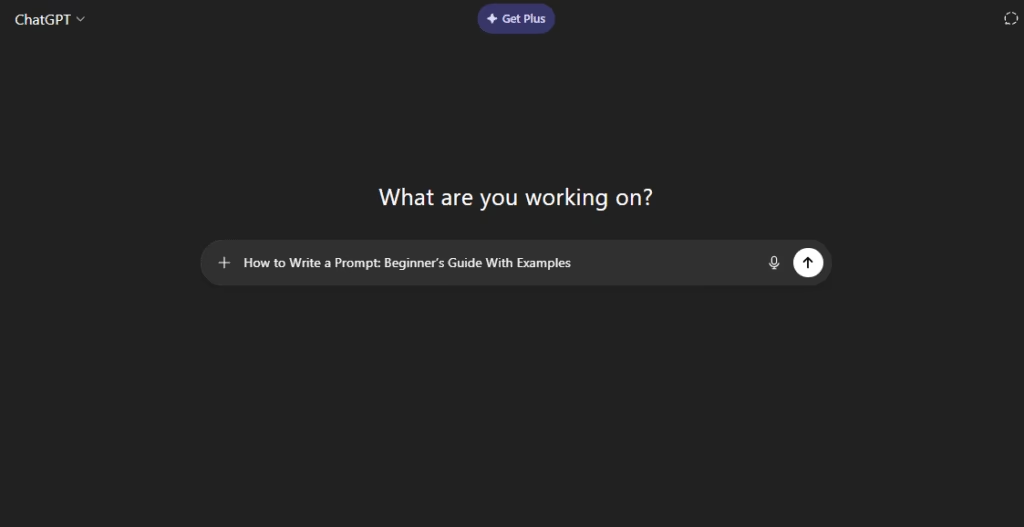How to Write a Prompt: Beginner’s Guide With Examples

If you’ve ever asked ChatGPT for something and got a vague, unhelpful answer, the problem might not be the AI — it might be your prompt. Ultimately, learning how to write a prompt is the key to getting exactly what you need, whether that’s a sales script, an Instagram caption, or even a full blog post.
In this beginner’s guide, you’ll learn:
- The right way to structure a prompt
- Examples for ChatGPT, writing, and image generation
- Common mistakes to avoid
What Is a Prompt?
A prompt is the instruction you give to an AI tool. It tells the AI:
- What you want (type of output)
- How you want it (tone, style, format)
- Extra details (keywords, audience, examples)
How to Write a Good Prompt – Step by Step
Step 1 – Be Specific
❌ Write about coffee.
✅ Write a 300-word blog about the benefits of black coffee for fitness enthusiasts, in a friendly tone, with 3 bullet points.
Step 2 – Give Context
Include details about:
- Target audience
- Purpose of content
- Preferred style
Example: “Write a persuasive LinkedIn post for marketing professionals explaining why AI is essential in 2025, with a motivating tone.”
Step 3 – Use Keywords Naturally
If you want your content to rank, add keywords: “Write a beginner’s guide on how to write a prompt for ChatGPT that creates human-like blog posts.”
Step 4 – Test and Refine
Of course, your first try may not be perfect. Instead, ask the AI to rephrase, add details, or change the style until it matches your needs.
Examples of Good Prompts
Writing: “Write a short story about a detective in Mumbai, in the style of Agatha Christie, with a twist ending.”
ChatGPT Sales Script: “Create a 30-second sales script for a ₹499 weight loss diet plan, targeting busy Indian women, in a friendly and persuasive tone.”
Instagram: “Write an engaging caption for a beach sunset photo with motivational quotes and a call-to-action to comment.”
Image Generation: “Create a realistic 4K image of a modern Indian kitchen with sunlight streaming through the window, fresh vegetables on the counter, and a cup of chai steaming in the foreground.”
Also read this: Google Veo 3, the beginner’s guide on how to use
Common Prompting Mistakes
- Being too vague
- Forgetting the audience
- Using overly complex language
- Not giving examples for reference
FAQ – Prompt Writing for Beginners
Q1: How do I start a writing prompt?
Begin by deciding exactly what you want the AI to create and who the audience is. Then, choose the format—such as a blog post, sales script, Instagram caption, or email. Adding details like tone, style, and word count will help ensure your prompt produces accurate, beginner-friendly results.
Example: “Write a 500-word guide for beginners on how to start yoga at home, using simple language and bullet points.”
Q2: What is an example of a prompt?
A good prompt clearly explains what to write, how to write it, and any important details. The more specific your instructions, the better ChatGPT can create human-like, high-quality content.
Example: “Write a 100-word product description for organic honey, highlighting its natural health benefits, purity, and rich taste.”
Q3: What is a writing prompt example?
A writing prompt is a short instruction or scenario that inspires ideas for content creation. It can guide ChatGPT or other AI tools to produce original, creative, or descriptive text that matches your goal.
Q4: What is the correct way to write a prompt?
The correct way to write a prompt is to combine clarity, context, and constraints. Start with the main task, give background details, and set rules like word count, style, or audience type to guide ChatGPT’s response.
Example: “Create a YouTube script for a 3-minute video explaining AI to high school students, using everyday examples and simple language.”
Q5: How do I create my own prompt?
Think about the final output you want, then reverse-engineer your instructions. Identify the topic, tone, audience, and format so your prompt leads to accurate and relevant results.
Q6: Is prompt writing a skill?
Yes — prompt writing is a skill that improves with practice. By testing and refining your instructions, you can consistently create ChatGPT prompts that generate high-quality, relevant, and human-like responses.
Q7: What is the format of a prompt?
A clear format helps AI understand your request:
- Task: What you want the AI to do
- Details: Tone, style, perspective, or format
- Constraints: Word count, keywords, or special requirements
Q8: How to write prompts for ChatGPT?
Be clear about the role, audience, and style you want the AI to use. You can also ask it to follow specific examples or mimic a certain tone so the result feels natural and relevant to your goal.
Example: “Write a friendly yet professional email inviting a client to a product demo, with a clear call-to-action and a curiosity-driven subject line.”
Q9: What are examples of creative prompts?
Creative prompts encourage imaginative and original output from ChatGPT. They are ideal for storytelling, descriptive writing, or generating unique art concepts.
- “Write a poem from the perspective of a cup of chai watching the sunrise.”
- “Describe a wedding taking place in outer space, complete with music and food details.”
- “Generate an image of a rainy street in Tokyo, with neon lights reflecting off wet pavements.”
Conclusion
Learning how to write a prompt isn’t hard — it’s a skill you can master in days. Start with clear, specific instructions, add context, use keywords naturally, and refine until the results sound just right.
Whether you want to write like a human, create a sales script, or engage your Instagram followers, the right prompt is the key to unlocking AI’s full potential.